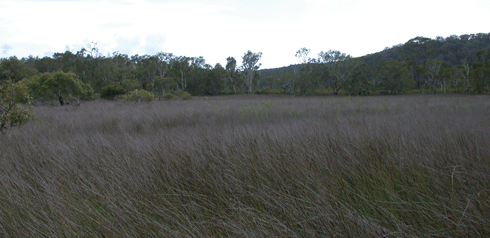
|
Published: 20 May 2013
Carbon farming could restore Australia's southern coastal wetlands
Australia’s southern coastal wetlands are more diverse than most people realise. In a recent paper, Paul Boon suggests they provide valuable ecological services that exceed those of inland wetland ecosystems. But these wetlands face enormous pressures from urban development and climate change. Fifty per cent of coastal wetlands have been lost from the east coast of Australia.

|
|
Restoring our southern wetlands as carbon farms would have many additional benefits to the ecosystem and the public. Credit: Catherine Lovelock
|
Despite this staggering loss we don’t know enough about them to manage or restore them effectively because of years of under-valuing, under-researching, under-funding and under-managing them. We now have an opportunity to redress the poor treatment of our southern coastal wetlands.
Wasted wetlands to carbon farms
Coastal wetlands store and sequester large amounts of carbon in their soils. Carbon farming is encouraged in the land-based environment to improve condition of the landscape and provide offsets for activities that emit carbon dioxide. Carbon farming could be encouraged in coastal wetlands, with restoration and improved management providing the possibility of benefits for biodiversity, fisheries, coastal protection and recreation.
The carbon value arises because the plants of coastal wetlands are highly productive in contributing their own carbon to the soils. They can also ‘trap’ carbon from other locations that is delivered with water flows. Additionally the low oxygen levels in their waterlogged soils inhibit decomposition of the carbon in the organic matter that is deposited leading to large stores of carbon in their soils.
Recent studies of the carbon gains of restoration of saltmarsh in Australia indicates that about 0.6–1.4 tonne of carbon per hectare per year is stored in these wetlands (Howe et al.) compared to 0.1–0.3 tonne per hectare per year in agricultural soils when management is improved (CSIRO agricultural soils report). With the restoration of these ecosystems the potential for carbon sequestration far exceeds that of land-based ecosystems on a per hectare basis.
Rogers et al. estimate that opening flood gates and allowing sea water with sea level rise into the Hunter River system could result in an additional 750 000 tonnes of carbon sequestered by 2100.
Saltmarshes and mangroves are only two of the sixteen coastal wetland types listed in Boon’s paper. Other types, such as estuarine wetlands and melaleuca forests are known to have highly organic soils and are also likely to sequester large amounts of carbon.
Seizing the opportunity
Including coastal wetlands in the Carbon Farming Initiative (CFI) would not require any changes in the current legislation, because restoring drained wetlands is already listed as an eligible activity. This could be extended further to include restoration of degraded wetlands.
The possibility of carbon sequestration projects in wetlands has already been established, with mangrove projects operating under the international voluntary carbon markets. Additionally, it is feasible that insurance can be obtained for carbon in wetlands.
Multiple benefits would flow from including restoration in the CFI. Many coastal wetlands in southern Australia are contained within privately-owned properties, and recognising the carbon sequestration values of well managed wetlands can have a positive impact on property values. The Department of Climate Change and Energy Efficiency’s recent assistance package to regional Natural Resource Management groups could be used to explore the benefits from carbon farming by restoring coastal wetlands.
Better still would be to include in the CFI a mechanism for including restoration of wetlands on public lands. This would go some way to reversing the degradation and loss that is occurring.
National benefits
Although coastal wetlands are currently managed mainly at the level of state and local government as well as by private landholders, they are a vital national asset.
The Australian Government will benefit from coastal wetland restoration because of improved habitat for biodiversity, flood control and water quality improvement. But also the Government stands to benefit from the new wetlands accounting framework of the IPCC that is currently under review and likely to be ratified in October 2013. In this document the conversion and degradation of coastal wetlands will have an established carbon cost, and their maintenance and restoration will assist in Australia’s carbon balance.
Although the Australian and state governments have legislative control over coastal wetlands, often the cost of day-to-day management of coastal wetlands is at local government level with a plethora of demands placed on their limited resources.
A modified Carbon Farming Initiative that can include restoring publicly-owned wetlands may provide badly needed resources for local governments to manage wetlands in a way that increases their carbon sequestration with the additional benefits to biodiversity, fisheries, water quality, flood control and recreation. Ultimately our whole society benefits from having intact, functional and diverse wetlands.
Catherine Lovelock is Professor of Biology at the University of Queensland, whose research focuses on the ecology and ecophysiology of coastal plant communities. Justine Bell, Postdoctoral Fellow in Law at the University of Queensland, is studying legal issues surrounding sea-level rise and flooding. Kerrylee Rogers is Research Fellow at the University of Wollongong, whose work focuses on planning for climate change in the coastal zone. Colin Creighton of the Fisheries Research Development Corporation, Neil Saintilan of the NSW Office of Environment and Heritage and Anissa Lawrence of TierraMar Consulting also contributed to this article. It was originally published at The Conversation.



